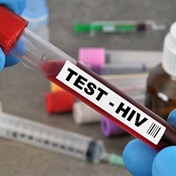The widespread rape of women and girls in the Democratic Republic of Congo and other conflict-torn African nations could be spurring a significant number of new HIV infections, a new study suggests.
Using a statistical model, researchers estimated that as many as 10,000 girls and women could be infected with HIV in Congo each year as a result of mass rape, assuming "extreme" levels of sexual violence. That figure could be as high as 20,000 in Uganda.
The findings, reported in the journal AIDS, point to one more consequence of the long-running armed conflicts in a number of sub-Saharan African nations.
In Congo alone, it's estimated that war has left more than 5 million dead since 1998. Although the nation held successful elections in 2006, violence simmers in much of the east, where both rebel and government army units roam, often looting and targeting civilians.
1,000 women raped per month
Women and girls have often been the victims. According to a UN report, more than 1,000 women were raped each month in Congo between November 2008 and March 2009. But since many rapes go unreported, the actual numbers could be much higher.
Sub-Saharan Africa is home to the greatest number of armed conflicts in the world, with many of the affected nations also having a high prevalence of HIV, the researchers on the new study note in their report.
That combination means that systematic rape could be helping to fuel the spread of HIV. But actual data have been lacking - in part because the true prevalence of rape in these war-torn areas is difficult to pin down.
For their study, researchers led by Virginie Supervie of the French national research institute INSERM created statistical models to try to estimate the impact of mass rape on HIV rates in Congo, Uganda, Burundi, Rwanda, Sierra Leone, Somalia and southern Sudan.
High prevalence of HIV
All of those areas have a high prevalence of HIV, and mass rape has occurred in each.
The researchers used survey data on rape prevalence, studies on the prevalence of HIV among military forces in the countries, and other sources to estimate the probability of HIV transmission through mass rape.
According to their calculations, Somalia and Sierra Leone would have the fewest transmissions. The median, or midpoint, number of annual infections due to rape would be 127 and 156, respectively.
Congo and Uganda would see the highest numbers - where, according to Supervie's team, a median of 1,120 and 2,172 women, respectively, could be infected each year.
But under "extreme conditions" - assuming 15% of girls and women between the ages of 5 and 49 were raped - as many as 10,000 females in Congo and 20,000 in Uganda could become infected with HIV per year, the researchers estimate.
The findings
Research suggests that the prevalence of mass rape in armed conflicts does reach such levels. Supervie's team points to a study of sexual violence against women during Liberia's civil war of the 1980s and 90s; 15% of women said they had been raped or sexually coerced.
These latest findings, the researchers write, underscore the urgent need for support services for rape victims in these countries, as well as medical interventions - including anti-HIV drugs that, taken shortly after an assault, could prevent infection.
However, getting such resources into conflict-torn countries, and then to the women who need them, remains a huge obstacle.
"Even raising the issue of rape in conflict situations can itself prove hazardous," Supervie and her colleagues write.
Women reluctant to report
In the Darfur region of Sudan, for example, women historically could be imprisoned for reporting rape, as could any healthcare provider who helped them. That policy changed in 2005, but many women remain reluctant to come forward, and health workers afraid to treat them, Supervie's team points out.
A report last year from the international humanitarian group Doctors Without Borders (Medecins Sans Frontieres) listed violence against civilians and lack of access to any healthcare in Congo, Somalia and southern Sudan among its top 10 humanitarian crises of 2009.
Also making the list was what the group described as "stagnant" funding for HIV/AIDS treatment in Africa and other areas where the infection is epidemic. The report said that in some African nations, people seeking HIV/AIDS medication are being turned away from clinics. (Reuters Health/ October 2010)
Read more: Childbirth hard for rape victims




 Publications
Publications
 Partners
Partners














